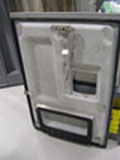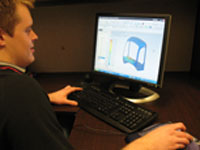Natural Fibres Reinforce Bus Parts
 As reported in prior newsletters, the CIC, together with an international consortium of agricultural producers, industry partners, research organizations and government agencies, has been diligently working towards developing and commercializing end uses for natural fibres from flax and hemp plants. Logically, it has been in the interest of our centre to focus on natural fibre structural reinforcements for composite parts replacing fiberglass as a material of choice. These investigations have culminated in a major milestone being reached; the manufacture of a prototype bus door assembly for a ground vehicle application. Specifically, an exterior battery door for an over-the-road coach application was reproduced with a hemp fibre mat replacing the fiberglass reinforcements. This air-lay needle punched mat, made up of hemp fibres, evolved from assessment of numerous textile fabrication processes and material combinations. Only minor changes were required to the existing resin infusion process to allow parts to be successfully manufactured. ‘This milestone was originally conceptualized in 2005,’ said Mercedes Alcock, Project Lead for Biomaterials at the CIC, “although there are still hurdles to overcome, it is certainly a rewarding moment to be able to make a recognizable product meeting many of the requirements established by industry for this type of application”. Work is continuing to ‘realize the dream’ of having natural fibres reducing the weight and cost and improving the performance of structural composite products. As part of this initiative, the CIC has created a volume of natural fibre mat materials. If your organization is interested in receiving a sample for assessment purposes, please contact Stephen Meatherall at the CIC (Email: smeatherall@compositesinnovation.ca; Tel. (204) 262 3400 ext. 225)
As reported in prior newsletters, the CIC, together with an international consortium of agricultural producers, industry partners, research organizations and government agencies, has been diligently working towards developing and commercializing end uses for natural fibres from flax and hemp plants. Logically, it has been in the interest of our centre to focus on natural fibre structural reinforcements for composite parts replacing fiberglass as a material of choice. These investigations have culminated in a major milestone being reached; the manufacture of a prototype bus door assembly for a ground vehicle application. Specifically, an exterior battery door for an over-the-road coach application was reproduced with a hemp fibre mat replacing the fiberglass reinforcements. This air-lay needle punched mat, made up of hemp fibres, evolved from assessment of numerous textile fabrication processes and material combinations. Only minor changes were required to the existing resin infusion process to allow parts to be successfully manufactured. ‘This milestone was originally conceptualized in 2005,’ said Mercedes Alcock, Project Lead for Biomaterials at the CIC, “although there are still hurdles to overcome, it is certainly a rewarding moment to be able to make a recognizable product meeting many of the requirements established by industry for this type of application”. Work is continuing to ‘realize the dream’ of having natural fibres reducing the weight and cost and improving the performance of structural composite products. As part of this initiative, the CIC has created a volume of natural fibre mat materials. If your organization is interested in receiving a sample for assessment purposes, please contact Stephen Meatherall at the CIC (Email: smeatherall@compositesinnovation.ca; Tel. (204) 262 3400 ext. 225)
CIC Adopts “State of the Art” Product Design Capabilities
 As the composites manufacturing industry matures, there has been significantly more interest in companies spending the time to properly develop their design ideas as opposed to the more traditional “building it and see if it works” approach. This interest has been readily evident at the CIC as we have been increasingly approached by a diverse group of our industry partners to support both product development and the resolution of complex production issues. A recent review of the current ‘State of the Art’ engineering design tools has led to an update of our stand alone Computer Aided Design (CAD) and Finite Element Analysis (FEA) tools to an integrated capability. ‘Selection of the Siemens NX6’s integrated modeling, simulation and analysis package provides us with a much more efficient design and analysis process”, stated Mark Townsley, CIC’s Ground Transportation Projects Lead,’ these tools enable the designer to quickly change concepts and reassess them without transferring files between programs and having the potential for errors to creep in.” Other benefits include improved confidence that the analysis results are accurate with the mature solver, NASTRAN, being part of the system. The analysis of composite components is sometimes unreliable due the anisotropic nature of the materials which relates directly to how the solver processes their diverse properties. This new system will also speed up the manufacturing of prototype components as it provides the ability to model the drape of materials over complex shapes. This enables plies of material to be precut to fit properly in the mould prior to stepping on the manufacturing floor. The CIC looks forward to assisting our clients in improving their product design and development processes utilizing this enhanced capability.
As the composites manufacturing industry matures, there has been significantly more interest in companies spending the time to properly develop their design ideas as opposed to the more traditional “building it and see if it works” approach. This interest has been readily evident at the CIC as we have been increasingly approached by a diverse group of our industry partners to support both product development and the resolution of complex production issues. A recent review of the current ‘State of the Art’ engineering design tools has led to an update of our stand alone Computer Aided Design (CAD) and Finite Element Analysis (FEA) tools to an integrated capability. ‘Selection of the Siemens NX6’s integrated modeling, simulation and analysis package provides us with a much more efficient design and analysis process”, stated Mark Townsley, CIC’s Ground Transportation Projects Lead,’ these tools enable the designer to quickly change concepts and reassess them without transferring files between programs and having the potential for errors to creep in.” Other benefits include improved confidence that the analysis results are accurate with the mature solver, NASTRAN, being part of the system. The analysis of composite components is sometimes unreliable due the anisotropic nature of the materials which relates directly to how the solver processes their diverse properties. This new system will also speed up the manufacturing of prototype components as it provides the ability to model the drape of materials over complex shapes. This enables plies of material to be precut to fit properly in the mould prior to stepping on the manufacturing floor. The CIC looks forward to assisting our clients in improving their product design and development processes utilizing this enhanced capability.
